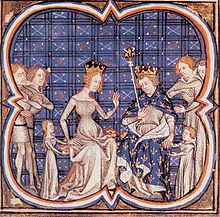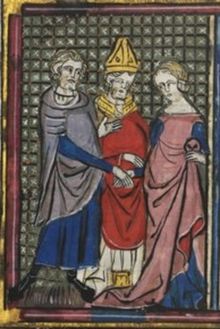- Constance of France, Princess of Antioch
-
Constance of France 
Princess consort of Antioch Tenure c.1093-1103? Countess consort of Champagne Tenure 1093/95-1104 Spouse Hugh, Count of Champagne
Bohemond I of AntiochIssue Bohemond II of Antioch House House of Capet Father Philip I of France Mother Bertha of Holland Born 1078 Died January 1124/1126 Constance of France (1078- January 1124/1126) was the daughter of King Philip I of France and Bertha of Holland. She was a member of the House of Capet and was princess of Antioch from her second marriage and Countess of Champagne from her first marriage. She was regent during the minority of her son.
Contents
Family
Her mother was repudiated by her father for Bertrade de Montfort. It caused the displeasure of the church and an interdict was placed on France several times as a result. Constance was the eldest of five children and was the only daughter of her father from his first marriage. Constance's brother was Louis VI of France.
Her maternal grandparents were Floris I, Count of Holland and his Gertrude of Saxony. Constance's paternal grandparents were Henry I of France and his second wife Anne of Kiev.
First marriage
Between 1093 and 1095 Philip I had his daughter, Constance married to Hugh, Count of Champagne.[1] Philip's purpose with this marriage was to influence Hugh's family, the powerful House of Blois, to offset the opposition of Count Fulk IV of Anjou since Philip had stolen Fulk's wife, Bertrade. But this union was made much too late, Hugh's brother, Stephen II, Count of Blois, holder of most counties of the House of Blois was married. Stephen had married Adela of Normandy, daughter of William I of England, and their marriage had produced children. This marriage was not beneficial to Constance's father in any way now but Constance remained married to Hugh. Constance and Hugh had a son, but he died young. Some [2] also believe that they had a daughter Eléonore of Blois, this is however their niece.
After ten years, Constance demanded an annulment of their marriage, for unknown reasons. Constance obtained a divorce at Soissons on 25 December 1104. Philip never assisted Constance during this time. Philip soon died and Louis became King of France. Louis successfully restored the royal authority and tamed the unruly vassals. Constance could never expect help from her father but she could from her brother.[3]
Second marriage
Constance went to the court of Adela, wife of Stephen. She was acting as regent since Stephen was killed in the Holy Land. Adela was well educated and all seemed to be well at the Court. It appeared that Adela used all her power to help Constance get a divorce from Hugh, who later left to fight in the Holy Land.
At the same time, Bohemond I of Antioch was just released by the Turks. He returned to Europe to obtain relief for the Crusaders in the Holy Land. The regency of the Principality of Antioch was assured by Bohemond's nephew Tancred, Prince of Galilee. Bohemond now needed a wife. He impressed audiences across France with gifts of relics from the Holy Land and tales of heroism while fighting the Saracens, gathering a large army in the process. Henry I of England famously prevented him from landing on English shores, so great was his influence expected to be on the English nobility. His new-found status won him the hand of Constance. Of this marriage wrote Abbot Suger:
Bohemond came to France to seek by any means he could the hand of the Lord Louis' sister Constance, a young lady of excellent breeding, elegant appearance and beautiful face. So great was the reputation for valour of the French kingdom and of the Lord Louis that even the Saracens were terrified by the prospect of that marriage. She was not engaged since she had broken off her agreement to wed Hugh, count of Troyes, and wished to avoid another unsuitable match. The prince of Antioch was experienced and rich both in gifts and promises; he fully deserved the marriage, which was celebrated with great pomp by the bishop of Chartres in the presence of the king, the Lord Louis, and many archbishops, bishops and noblemen of the realm.
The marriage was celebrated in the cathedral of Chartres, and the festivities were held at the court of Adela, who also took part in negotiations. The groom took the opportunity to encourage the nobility to fight in the Holy Land, and also negotiated for a marriage between Bohemond's nephew Tancred, Prince of Galilee and Constance's half-sister Cecile of France.
Pleased by his success, Bohemond resolved to use his army of 34,000 men, not to defend Antioch against the Greeks, but to attack Alexios I Komnenos. He did so; but Alexius, aided by the Venetians, proved too strong, and Bohemond had to submit to a humiliating peace, (the Treaty of Devol in 1108).
After her marriage, Constance accompanied her husband to Apulia, where she gave birth to their only child, Bohemond II of Antioch (1107–1130), future Prince of Antioch. Bohemond became the vassal of Alexius, consented to receive his pay, with the title of sebastos, and promised to cede disputed territories and to admit a Greek patriarch into Antioch. Henceforth Bohemond was a broken man. He died without returning to the East, and was buried at Canosa in Apulia, in 1111.
Widowhood
Constance acted as regent of the duchies of Calabria and Apuleius on behalf of her son [4] and took the title of Queen as a daughter of the King of France, but she was imprisoned by Grimoald Alferanites, who proclaimed himself Lord of Bari. Constance was released in 1120 on the intervention of King Roger II of Sicily and the Pope,[2] but in exchange for her release, Constance had to give up the regency over her son.
She died on 14 September 1126, and Bohemond II then went to takeover his principality of Antioch.
Constance's granddaughter, also called Constance, became Princess of Antioch. Her children included: Maria, Byzantine Empress, Bohemund III of Antioch and Agnes, Queen of Hungary.
Ancestors
Ancestors of Constance of France, Princess of Antioch 16. Hugh Capet 8. Robert II of France 17. Adelaide of Aquitaine 4. Henry I of France 18. William I of Provence 9. Constance of Arles 19. Adelaide of Anjou 2. Philip I of France 20. Vladimir I of Kiev 10. Yaroslav I of Kiev 21. Rogneda of Polotsk 5. Anne of Kiev 22. Olof Skötkonung of Sweden 11. Ingegerd Olofsdotter 23. Estrid of the Obotrites 1. Constance of France [5] 24. Arnulf, Count of Holland 12. Dirk III, Count of Holland 25. Luitgard of Luxemburg 6. Floris I, Count of Holland 13. Othelendis of Saxony 3. Bertha of Holland 28. Bernard I, Duke of Saxony 14. Bernard II, Duke of Saxony 29. Hildegard of Stade 7. Gertrude of Saxony 30. Henry, Count of Schweinfurt 15. Eilika of Schweinfurt 31. Gerberga of Henneburg References
Categories:- French princesses
- 1078 births
- House of Capet
- 1120s deaths
- Medieval women
- Princesses of Antioch
- Countesses of Champagne
- Female regents
Wikimedia Foundation. 2010.


